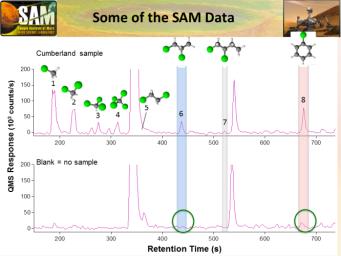
|
Some Data from Detection of Organics in a Rock on Mars
- Click the image above for a larger view
- Full-Res JPEG (960 x 720) (79.7 kB)
- Full-Res TIFF (960 x 720) (2.1 MB)
Caption:
Data graphed here are examples from the Sample Analysis at Mars (SAM) laboratory's detection of Martian organics in a sample of powder that the drill on NASA's Curiosity Mars rover collected from a rock target called "Cumberland."
SAM's analysis of the Cumberland sample yielded the first definitive detection of any Martian organic chemicals in material on the surface of Mars. Organic chemicals, which contain carbon and usually hydrogen, are molecular building blocks of life, although they can be made without life's presence. Martian organics could have been produced on Mars or delivered to Mars aboard meteorites.
The upper graph shows data from analysis of the Cumberland sample, drilled from mudstone bedrock in the Yellowknife Bay area of Mars' Gale Crater. The lower graph shows data from SAM's analysis of a blank containing no rock material. The differences, highlighted at positions labeled 1 through 8, indicate chemicals that were present in the sample but not in the blank.
The vertical scale is thousands of counts per second in SAM's Quadrupole Mass Spectrometer (QMS), an instrument that identifies gases by their molecular weight and the characteristic pattern of fragment ions generated during the analysis. The horizontal axis is the retention time, in seconds, as the sample gas or blank gas passes through the QMS.
The molecular diagrams at the top depict the chemical structures corresponding to the eight different molecules for which the Cumberland sample showed peaks and the blank did not. Green balls represent chlorine atoms. Smaller black balls represent carbon atoms. The bare sticks extending from carbon atoms represent bonds to hydrogen atoms. For example, peak number 1 corresponds to chloromethane, peak number 4 to carbon tetrachloride, peak number 6 to dichloropropane and peak 8 to chlorobenzene. The chlorine in these molecules may have resulted from reaction of Martian organic chemicals with Martian perchlorate during the process of heating the sample in SAM before the QMS step, so the identities of Martian precursor organic molecules remain to be determined.
Background Info:
NASA's Mars Science Laboratory Project is using Curiosity to assess ancient habitable environments and major changes in Martian environmental conditions. NASA's Jet Propulsion Laboratory, a division of the California Institute of Technology, Pasadena, built the rover and manages the project for NASA's Science Mission Directorate, Washington. NASA's Goddard Space Flight Center, Greenbelt, Maryland, built and operates SAM.
More information about Curiosity is online at http://www.nasa.gov/msl and http://mars.jpl.nasa.gov/msl/ .
Cataloging Keywords:
| Name | Value | Additional Values |
|---|---|---|
| Target | Mars | |
| System | ||
| Target Type | Planet | |
| Mission | Mars Science Laboratory (MSL) | |
| Instrument Host | Curiosity Rover | |
| Host Type | Rover | |
| Instrument | Sample Analysis at Mars (SAM) | |
| Detector | ||
| Extra Keywords | Color, Crater, Methane | |
| Acquisition Date | ||
| Release Date | 2014-12-16 | |
| Date in Caption | ||
| Image Credit | NASA/JPL-Caltech | |
| Source | photojournal.jpl.nasa.gov/catalog/PIA19089 | |
| Identifier | PIA19089 | |
